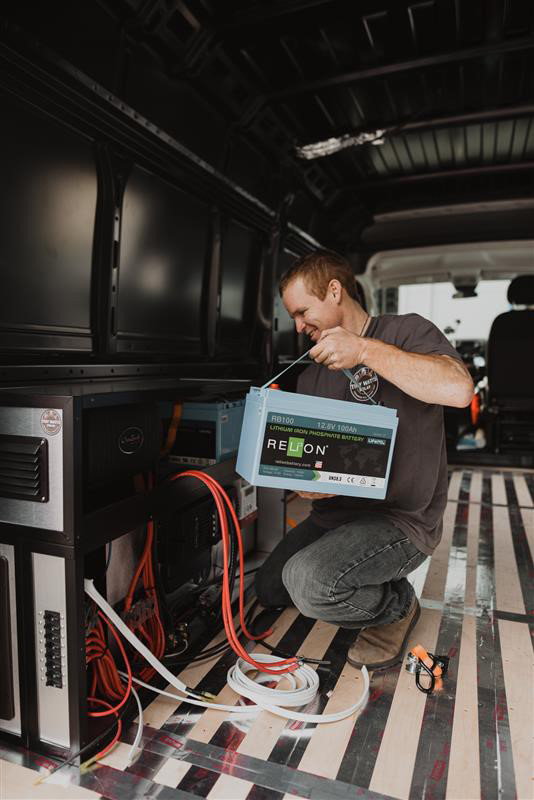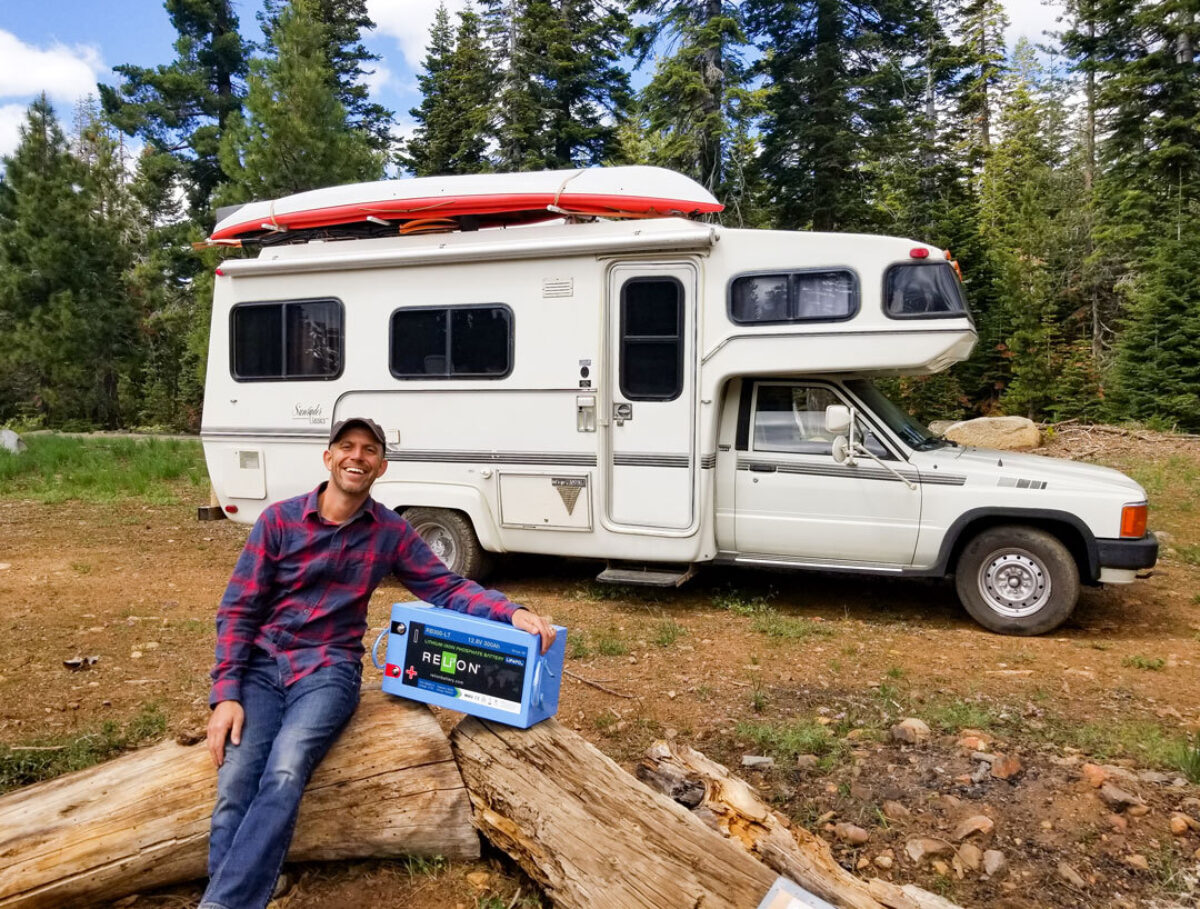Whether you plan to rent an RV or camper van for your next off-grid trip or have been boondocking for months or years, it’s critical to ensure your energy needs are sufficiently met by your RV batteries before your next trip. After the pandemic hit in 2020, first-time campers across the U.S. grew five-fold, with nearly half saying they plan to purchase an RV in the next 12 months. As a result, campgrounds with hookups, or water and electrical connections, have become significantly more crowded. Campers have increasingly been turning to boondocking, or living without hookups outside a developed campground, to enjoy greater peace and quiet in nature. We cover the pros and cons of boondocking with lithium batteries versus AGM or absorbed glass mat, batteries below - from space and weight differences, to charge and discharge capabilities, to longevity and safety.
Making Full Use of Limited Space and Weight in Your RV

A primary advantage of lithium batteries for boondocking in an RV is that they weigh about one-third less, on average, compared to lead acid batteries and are often also much smaller in size, freeing up crucial space in your vehicle. For example, the VMAX 200 Ah AGM battery, which only has a 100 Ah usable capacity due to only being able to be discharged down to 50 percent, weighs 82 pounds more, or over one-third more, than the RELiON RB100 LFP 100 Ah battery. The additional weight of an AGM battery in your vehicle can really add up, particularly if you have multiple batteries in your battery bank, resulting in lower fuel efficiency and additional funds required for gas or diesel fuel.
In addition to weighing down your vehicle and taking up limited cargo space, heavier AGM batteries also do not store significant amounts of energy relative to their larger size. This metric is referred to as energy density, or how much energy can be stored in relation to the battery’s weight and space. Lithium RV batteries have a much higher energy density than lead-acid batteries. In other words, lithium batteries can store three to four times as much energy compared to the same size lead-acid battery, which gives you more energy to last you through every day, while also maximizing available space in your RV. This higher energy density is a huge benefit for mobile use cases, especially longer-term boondocking trips, due to the fact that weight and space are so limited.
Minimizing Charge Time and Hassle to Maximize Your Trip
Here are 3 advantages that deep cycle lithium batteries have over AGM.
- Depth Of Discharge
- Roundtrip Efficiency and Charge Time
- Tolerance for the Partial States Of Charge
Depth of Discharge
There are several considerations to take into account when comparing the charge and discharge capabilities of AGM versus lithium batteries, starting with a depth of discharge, or the percentage of the battery that has been discharged or used, relative to the total capacity of the battery. A major disadvantage of lead-acid batteries is that they cannot be fully, or 100 percent, discharged. While AGM batteries can be discharged up to 80 percent, or about 30 percent more than standard flooded lead-acid batteries, AGM batteries cannot be discharged 100 percent as lithium batteries can. You will therefore need to spend more time charging your AGM batteries rather than actually using them compared to lithium batteries. You will also have to plan your daily activities around the requisite additional charging times as a result of the AGM battery’s more limited capacity.
Roundtrip Efficiency and Charge Time
Secondly, the charging and discharging process for lithium batteries is more efficient than that of all lead-acid batteries, which translates into more of your solar power being stored and used rather than lost during the charge and discharge cycles. Specifically, lead-acid batteries are only 80 to 85 percent efficient on average, depending on the model and condition. Therefore, if you have 1,000 watts of solar power coming into the batteries, there will only be 800 to 850 watts available for use after the charging and discharging take place. On the other hand, lithium batteries are over 95 percent efficient, or 15 to 20 percent more efficient than the average lead-acid battery. In other words, and using this same example, you would have over 950 watts of power available to use compared to just 800 to 850 watts in the lead-acid battery scenario.
In addition to providing more energy, more efficient batteries also charge faster because there are fewer energy losses during the charging process. Depending on the configuration of your system, this could result in you purchasing fewer solar panels and/or a battery bank with a smaller capacity since you will have more usable capacity on a daily basis with a solar battery bank that charges faster. Specifically, lithium batteries charge approximately four times faster than lead-acid batteries, on average, since they can handle a higher amperage from the charger. Although AGM batteries charge faster than wet cell lead-acid batteries, AGM batteries still charge significantly slower than lithium batteries. This slower charge time directly results in lower usable capacity per day as well as may potentially require you to keep your vehicle and solar array in a particular location for a longer period of time in order to reach a full charge, thereby limiting your freedom.
Tolerance for the Partial States of Charge
Lastly, you have much more flexibility when it comes to charging the lithium batteries, as you are able to start and stop the charge as needed with no impact on battery performance or lifespan, unlike lead-acid batteries. These charge characteristics mean that there is no concern about completing a long absorption cycle like there is with AGM batteries. However, when you only partially charge AGM batteries and don’t charge them back up to 100 percent every single time, they lose their capability to charge to full capacity over time. If you constantly charge your AGM battery to only 70 percent, for example, the battery may eventually fail to charge past 70 percent. This then reduces the lifespan of the AGM battery. As a result, lithium batteries are much more suitable for partial charge applications such as solar energy collection and regenerative braking from vehicles. In other words, if you want the freedom to relax and explore as you please without worrying about fully recharging the battery versus leaving it in a partially charged state, lithium batteries are the way to go.

Long-Lasting Batteries to Prevent Replacement Costs
Although lithium batteries often have a higher upfront price point, they offer a much longer lifespan than lead acid batteries, as you truly get what you pay for. A single lithium battery often lasts 10 times longer than its lead acid counterpart, on average. Measured by cycle life, or how many times a battery can be drained and then recharged before it needs to be replaced, lithium batteries offer a 5,000 to 10,000 cycle life when discharged up to 80 percent. On the other hand, AGM batteries might be capable of 400 to 1,000 cycles, depending on their maintenance, quality, and depth of discharge. If you cycled your lithium battery once a day, it would offer more than 14 years of life, while a standard lead acid battery often lasts two years or less. While AGM batteries often last longer than other lead acid batteries, their lifespan still pales in comparison to all types of lithium batteries. If you’re boondocking in an RV and charging your batteries every single day, then you will go through lead acid batteries much faster than lithium. You might even need to replace your lead acid batteries every year depending on your depth of discharge and maintenance habits. Additionally, one of the best ways to determine the minimum lifespan of the battery you are considering is to take a look at the battery manufacturer’s warranty. To learn more about how to calculate your energy needs and find the optimal battery for your application and usage, visit our Lithium Battery Selector Tool.
Ensuring Your Safety While Also Avoiding High Maintenance Batteries
As you will be sleeping and living in close proximity to your battery bank, safety is a critical factor to consider. For example, many lead-acid batteries, including AGM batteries, need to be in a properly ventilated compartment within your vehicle in order to prevent the build-up of dangerous hydrogen gas that can poison the breathable air, as well as cause battery damage and, in worst-case scenarios, explosions. If you allow hydrogen gas to accumulate in your vehicle, even a small spark can ignite the air and cause serious damage to your vehicle. This is the last thing you want to be worrying about on your next road trip. Alternatively, all lithium batteries have the advantage of not producing hazardous hydrogen gas. Even better, LFP (i.e., lithium iron phosphate or LiFePo4) batteries in particular also do not pose a risk of thermal runaway, unlike lithium cobalt-based batteries. As a result, LFP batteries can also often be installed on their side and in more space-restricted compartments.
In sum, while AGM batteries beat lithium batteries when it comes to up-front price points, lithium AGM batteries don’t stand a chance against lithium batteries in every other category you will want to consider when boondocking. By opting for lithium batteries, you will avoid the expensive and consistent replacement costs that come with shorter life span AGM batteries while reaping benefits across the board - from faster charge times to higher efficiency to greater depths of discharge to safety to less maintenance.

If you are preparing for your next boondocking adventure and want to learn more about how AGM batteries compare to lithium batteries, please contact our team of experts to help you decide what will be the best fit for you.
